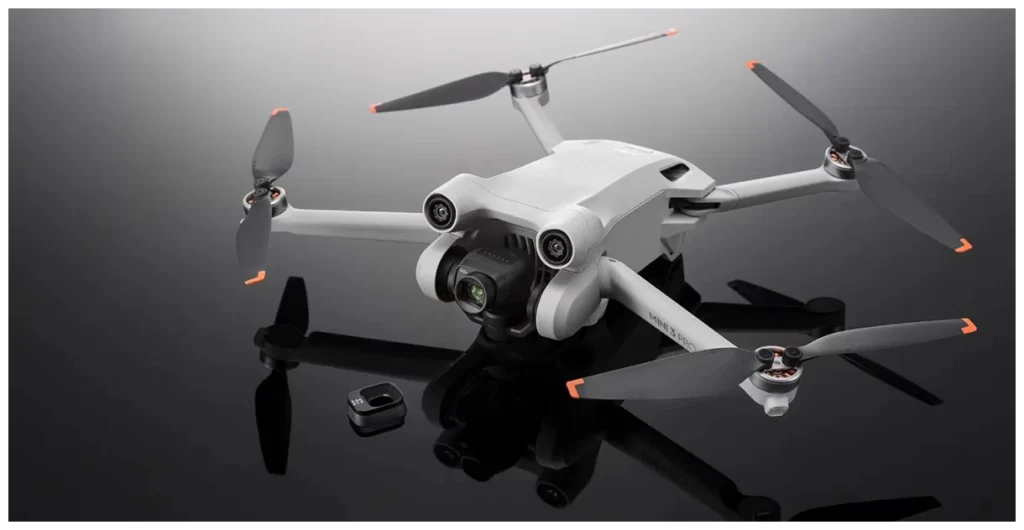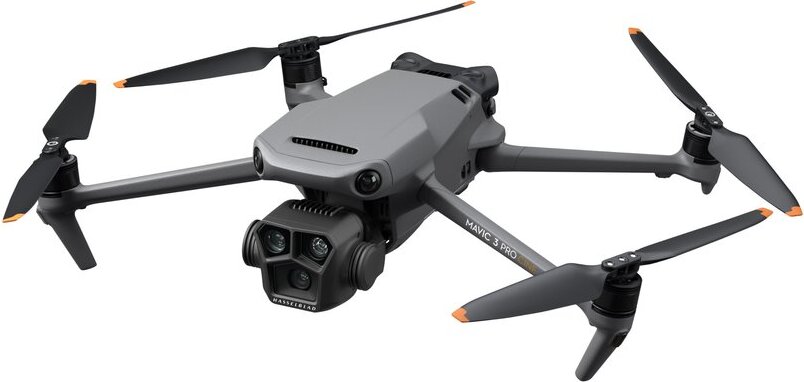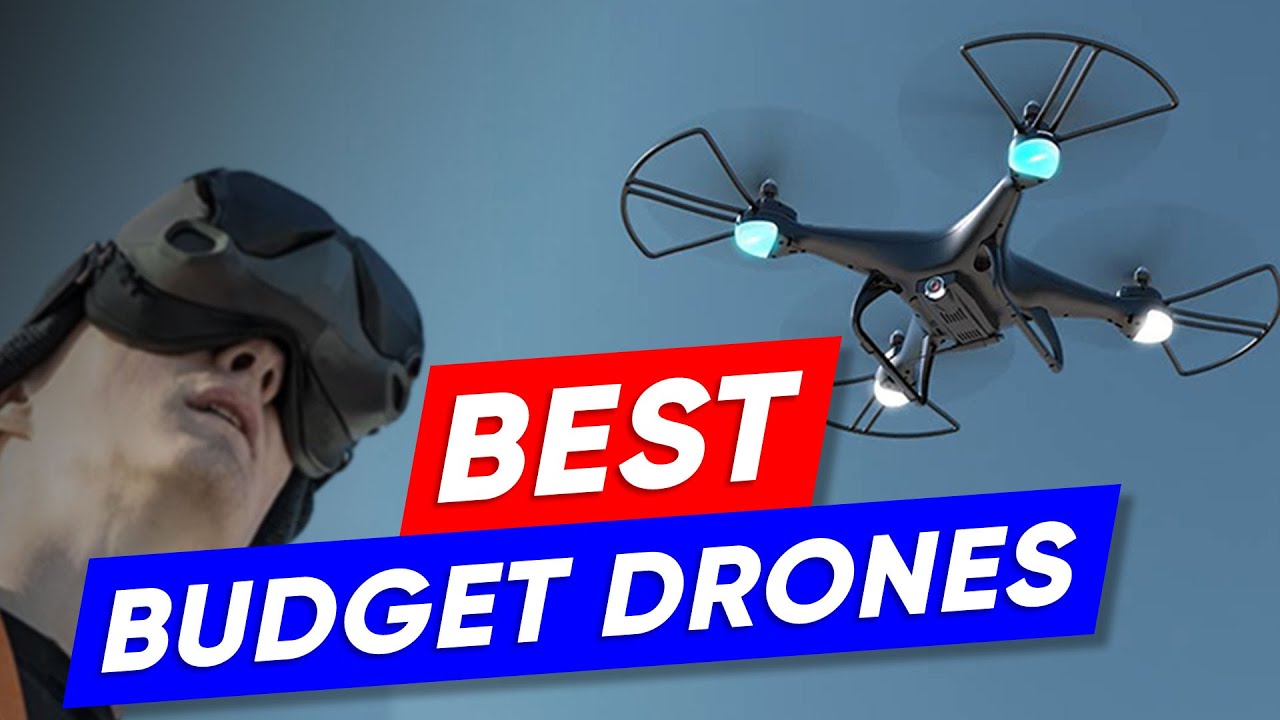The best drones make it simple to take stunning aerial photos and videos. The best options make it simple to take off and provide you access to aerial perspectives that were previously only available to helicopter passengers thanks to their high-resolution sensors and automated safety systems. Because of this, drones have become the equipment of choice for a large number of photographers and filmmakers.
Our rigorous testing has led us to believe that the DJI Mini 3 Pro is currently the best drone for the majority of consumers. With a superb camera and three-directional obstacle avoidance, it has an outstanding skill set for such a little drone. It’s one of the best beginner drones because it’s simple for beginners to fly.
1. DJI Mini 3 Pro

Specifications:
Here are the specifications of the DJI Mini 3 Pro:
| Specifications | Description |
| Weight | 249g |
| Controller: | Yes |
| Camera resolution: | 12.1MP |
| Flight time: | 34 minutes |
| Range: | 8km-12km |
The DJI Mini 3 Pro, in our opinion, is the greatest mini drone you can buy since it offers the performance of larger drones in manageable proportions. Although it costs more than previous Mini models, the Mini 3 offers a significant improvement over the Mini 2. In exchange for your money, you receive a much better camera, obstacle avoidance sensors, and a number of in-flight functions that are often reserved for larger drones.
In our review, we discovered that the 12.1 MP 1/1.3-inch sensor in the Mini 3 Pro delivered very good image quality. The Mini 3 Pro performs admirably in low light thanks to a bright f/1.7 lens and dual native ISO technology, with very little noise even at the highest ISO of 6400.
2. DJI Air 3

Specifications:
Here are the specifications of the DJI Air 3:
| Specifications | Description |
| Weight | 720g |
| Controller: | Yes |
| Camera resolution: | 12/48MP |
| Flight time: | 45 minutes |
| Range: | 10-20km |
The DJI Air 3 provides a substantial improvement over the already capable Air 2S from 2021, with twin cameras and greater wind resistance. The Air 3 falls into Europe’s C1 category with a take-off weight of 720g, which means it is subject to more regulations than the sub-250g drones on this list. However, there are several advantages to having additional baggage, one of which is a generous 46-minute travel time.
As we have come to expect from DJI, we discovered class-leading image quality throughout testing. However, we discovered that the 3x zoom lens allows you to operate at a safe and legal distance from creatures, which is a great feature if you’re filming wildlife. Fixed apertures aren’t beneficial for users of ND filters.
3. Autel Evo Lite+

Specifications:
Here are the specifications of the Autel Evo Lite+:
| Specifications | Description |
| Weight | 840g |
| Controller: | Yes |
| Camera resolution: | 12 MP |
| Flight time: | 44 minutes |
| Range: | 16km |
In direct competition with the Air 2S is the Evo Lite+, the flagship drone from Autel’s most recent series of DJI rivals. It has a startlingly identical spec list and uses a 1-inch sensor to capture 5.4K footage at 30 frames per second. But it also outperforms the Air 2S and the Mavic Pro 2 because of its variable aperture (ranging from f/2.8 to f/11) and 40-minute flight time. The larger pixels on the Lite+ model’s sensor allow it to collect more light in dimly lit conditions, despite the fact that it lacks the fourth-axis stability of its Evo Lite sister.
Professional drone videographers may wish to reconsider the absence of 10-bit footage and D-Log profiles, while it is unfortunate that side sensors for obstacle avoidance were not included. In contrast, we discovered in our review that the Lite+ is an incredibly adaptable piece of flying camera gear. Given the price, the 20MP sensor is likely the greatest drone camera currently on the market, giving the Air 2S some significant competition.
4. DJI Mavic 3 Pro

Specifications:
Here are the specifications of the DJI Mavic 3 Pro:
| Specifications | Description |
| Weight | 960g |
| Controller: | Yes |
| Camera resolution: | 12/48MP |
| Flight time: | 50 minutes |
| Range: | 18km |
The first consumer drone with three cameras is DJI’s latest model. Most pilots don’t need more than this. The Mavic 3 Pro, however, appears to be the best choice if you’re an aerial photographer or videographer looking for the most adaptable drone on the market, according to the findings of our tests.
Additionally, it triumphs in terms of formats, frame rates, and aperture adjustments. However, the ability to zoom in 3x or 7x is really helpful in a variety of situations and is available on both telephoto cameras.
5. DJI Mini 3
Specifications:
Here are the specifications of the DJI Mini 3:
| Specifications | Description |
| Weight | 250g |
| Controller: | Yes |
| Camera resolution: | 12 MP |
| Flight time: | 35 minutes |
| Range: | 8km |
The Mini 3 is the most inexpensive drone you can acquire if you don’t need collision avoidance. It offers the same image quality as its more expensive sister and is smaller, lighter, and less expensive than the Mini 3 Pro. It’s a high-quality drone capable of taking superb JPEG and raw still photos as well as 4K video at up to 30 frames per second, provided you feel competent navigating in-flight obstacles without automatic aid. Its 12 MP sensor’s ability to pivot to capture portrait shots is advantageous.
Its attractiveness to pros is limited by the absence of Log profiles, and another degradation from the Pro edition is the lack of subject tracking. Despite this, the Mini 3 still has Quickshots, which let amateurs use automated flight routes to record cinematic footage. With the optional controller with downward vision sensors and GPS to assist in hovering, we found it to be a simple drone to fly. Upgrade to the Mavic 3 Classic to receive better image quality and more stability in windy conditions, but with reasonable real-world flying times of 25 minutes, the Mini 3 meets all the requirements for budget clients.
6. DJI Mavic 3 Classic

Specifications:
Here are the specifications of the DJI Mavic 3 Classic:
| Specifications | Description |
| Weight | 900g |
| Controller: | Yes |
| Camera resolution: | 20 MP |
| Flight time: | 47 minutes |
| Range: | 13km |
Technically inferior to the Mavic 3, the Classic model is less expensive since it lacks the telephoto lens of its more expensive sibling. The Classic is not a cheap option, but with this streamlined arrangement, filmmakers may use it more affordably. It keeps the superb 4/3 primary sensor, which is still the greatest camera a folding drone can have, in our opinion.
Although the Cine edition’s 1TB SSD and Apple ProRes recording are absent, we believe that most videographers won’t need more than its ability to record 5.1K video in Normal, HLG, and 10-bit profiles. Additionally, noise handling is excellent throughout the entire ISO range because of the bigger sensor.
Additionally, you receive all of the flight and security capabilities of the first-generation Mavic 3 models. Even though this isn’t a drone for complete beginners, we discovered during testing that the Classic was simple to fly with confidence because of features like automated Quickshots, subject tracking, and collision avoidance—even though the actual battery life was less than the advertised 46 minutes. The DJI Air 2S is more reasonably priced if you’re okay with a 1-inch sensor. The Mavic 3 Classic, however, is your best option if you want the highest image quality from a foldable drone.
7. Autel Evo Nano+
Specifications:
Here are the specifications of the Autel Evo Nano+:
| Specifications | Description |
| Weight | 260g |
| Controller: | Yes |
| Camera resolution: | 20MP |
| Flight time: | 38 minutes |
| Range: | 17km |
In the sub-250g category, the DJI Mini 3 Pro continues to be our favorite option, but the eye-catching Evo Nano+ isn’t far behind. Our tests revealed that its camera performance surpasses the DJI Mini 2 in low-light scenarios thanks to its large sensor and brilliant lens. Locking the exposure to ISO 3200 also significantly improved the outcomes after dark.
The Nano+ manages windy situations quite well for such a little drone despite falling under the 250g limit. In testing, it seemed to be very controlled, and three-way obstacle avoidance increased our trust, even if intense sunlight occasionally provided erroneous proximity warnings. Compared to the Lite+ (above), its body feels less sturdy, but when the battery is installed, rigidity increases.
Since we first tested the drone, the Autel fly app has seen significant improvement, with a streamlined UI for stills and video. Overall, the Evo Nano+ is a fantastic little drone that can capture gorgeous 4K/30p footage. The Evo Nano+ should be on your radar if you’re seeking for a portable DJI substitute that flies below most registration restrictions.
8. DJI Avata
Specifications:
Here are the specifications of the DJI Avata:
| Specifications | Description |
| Weight | 410g |
| Controller: | Yes |
| Camera resolution: | 48MP |
| Flight time: | 35 minutes |
| Range: | 12km |
The DJI Avata is, in our opinion, the best FPV drone currently available if you’re looking to explore the rapidly growing specialty of first-person drone flight. You can fly inside or outside while recording stunning 4K or 60p footage with a compatible controller and set of DJI Goggles. Professional photographers will appreciate the support for DJI’s flat D-Cinelike profile.
With the exception of one annoying design choice—inside one of the Avata’s blade rings, a microSD card slot—we found it to be a well-made drone with outstanding crash protection, thanks to its propellor guards. We only needed a few practice flights before we felt comfortable flying.
The Avata can use a variety of DJI controller models. These include conventional remote controls that are expected to be popular with purists as well as motion-sensitive alternatives like the DJI RC Motion 2, which causes the drone to react to the movements of the operator’s hands. For many students, this will be the option that makes the most sense.
In either case, you’ll be able to record original footage while flying the Avata at high speeds of 60 mph. The DJI Avata is a great option for beginning FPV pilots as long as you’re aware of its limitations—you’ll need a spotter if you’re shooting outdoors.
9. Ryze Tello

Specifications:
Here are the specifications of the Ryze Tello:
| Specifications | Description |
| Weight | 100g |
| Controller: | Optional |
| Camera resolution: | 6 MP |
| Flight time: | 15 minutes |
| Range: | 120m |
The Ryze Tello is a simple, lightweight, and enjoyable drone for beginners. The battery provided a respectable 13 minutes of flight time in testing, and downward-facing light sensors enabled the Tello to hover in position and carry out a number of automated tricks, despite its modest price.
In our assessment, we discovered that the 5MP camera positioned on the nose had less outstanding image quality, with a small dynamic range and visible compression artifacts when streaming 720p HD video. Any deterioration in connection strength has an impact on the frame rate because the video is broadcast directly to your smartphone.
However, we thought the app’s simplicity was refreshing. With a rewardingly snappy on-screen twin-stick arrangement, it provides a simple way to control the Tello. Despite the fact that even the smallest breeze can cause the 80-gram Tello to veer off course, even though the range is less than the theoretical 100 meters, it’s still not necessarily a terrible thing.
10. BetaFPV Cetus Pro Kit
Specifications:
Here are the specifications of the BetaFPV Cetus Pro Kit:
| Specifications | Description |
| Weight | 50g |
| Controller: | Yes |
| Camera resolution: | 6MP |
| Flight time: | 10minutes |
| Range: | 80m |
We believe that the BetaFPV is the best method for beginners to attempt first-person drone flight because it is a full yet reasonably priced FPV kit. A complete FPV setup, including goggles, batteries, and a console-style controller that you can also use to train in simulators, is included in the bundle.
The drone is amazingly light when it is delivered and is ready to fly. Although crashes are more common during FPV flight, the Cetus is designed to resist the majority of blows. Three-speed options and three flight modes provide flexibility for learners to advance, while Turtle Mode enables it to correct itself remotely. Normal proved to be the most straightforward to fly, while manual or acro was the most challenging and required precise throttle control.
There is no option to record still images or videos, and the battery life is only 4-5 minutes per charge, necessitating the use of backup batteries. But we still believe it to be the best choice if you want an inexpensive approach to trying out FPV.
How to choose the best drone for you
It is sensible to start with your budget when deciding on your ideal drone. Flagship drones often have the biggest sensors, the greatest video quality, and the newest professional-grade capabilities, but these typically cost thousands of dollars. Looking in the center of the pricing range, where products like the DJI Mini 3 Pro strike a mix between cost, portability, and performance, will frequently yield the best value. The Ryze Tello offers a respectable experience for only $99 or £99, making it a good choice for beginners looking for an inexpensive drone to get started.
Drones with safety features like obstacle avoidance, which reduce the risk of crashes in midair, are recommended for novice pilots. Automated flight modes also make it simple to perform dramatic maneuvers without the need for expert piloting abilities.
With most drones, you can use your smartphone as a controller by placing it in one of the provided handsets. It’s worthwhile to examine what remotes are compatible with a specific model if you’re an experienced pilot with particular control requirements. Depending on how you plan to fly, variables like flight time, range, and speed can also be quite important.
What are the laws around flying a drone?
In particular, close to important sites like airports and national parks, drone restrictions exist to maintain a high level of safety in the skies. They also seek to resolve privacy issues brought up by the use of camera drones near homes.
Drones weighing less than 250g are exempt from registration with civil aviation authorities in some countries, including the United States. Even if registration is not required, it is still important to abide by local drone rules. This includes the need to always have your drone in sight while it’s in the air.
There are various laws in different nations. Drones weighing less than 250g were previously exempt from registration in the UK. The requirement to register an aircraft with the Civil Aviation Authority and receive an Operator ID has altered, requiring owners of any drone with a camera to do so. For those who are 18 years of age and older, there is an annual cost of £10.33 for this registration.
You will also need a Flyer ID if the weight of your drone is greater than 250g. You must pass a 40-question multiple-choice test online in order to get this. The Drone Code contains solutions that are meant to encourage safer flying procedures.
Who makes the best drone?
For drones with cameras, DJI has long been the industry leader. Even though this is still the case, Chinese business has recently come under assault due to both heightened competition and run-ins with the US authorities. As you can see from the paragraph above, this hasn’t altered our recommendation that you purchase a DJI drone, but it is encouraging to finally see some healthy competition in the drone market.
For individuals who require ‘follow me’ capability, Skydio is a viable contender because it has established itself as a distinctive brand in the US for obstacle-avoidance abilities. Although there are now many options, we still believe that DJI is the best overall drone brand. This is especially true if you need a flying camera for a particular application.

